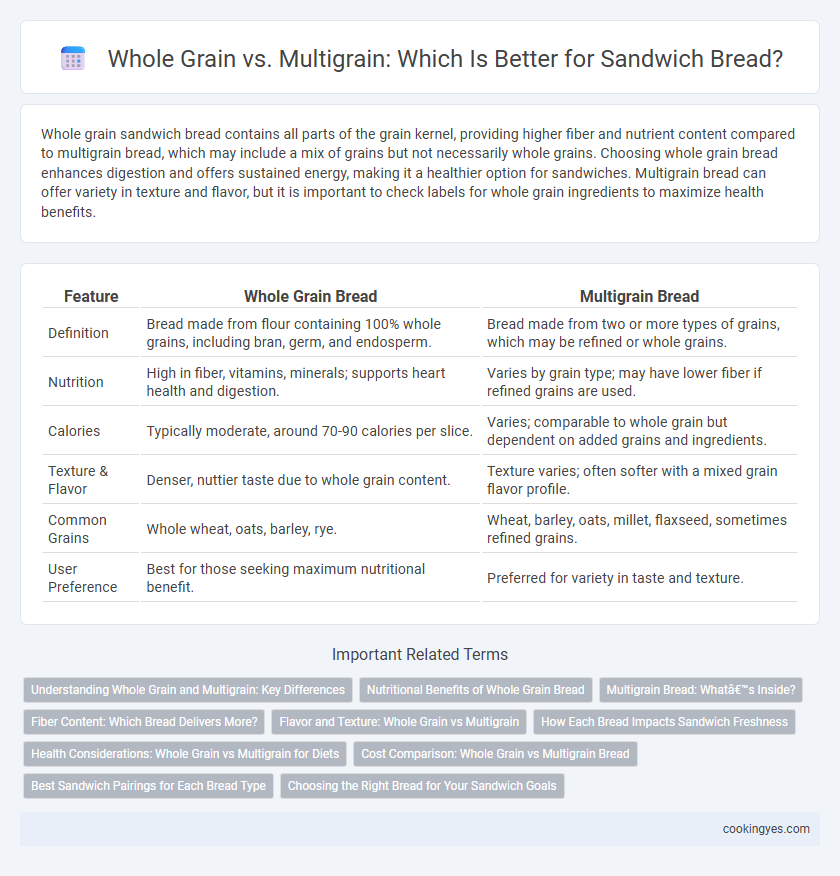Whole grain sandwich bread contains all parts of the grain kernel, providing higher fiber and nutrient content compared to multigrain bread, which may include a mix of grains but not necessarily whole grains. Choosing whole grain bread enhances digestion and offers sustained energy, making it a healthier option for sandwiches. Multigrain bread can offer variety in texture and flavor, but it is important to check labels for whole grain ingredients to maximize health benefits.
Table of Comparison
| Feature | Whole Grain Bread | Multigrain Bread |
|---|---|---|
| Definition | Bread made from flour containing 100% whole grains, including bran, germ, and endosperm. | Bread made from two or more types of grains, which may be refined or whole grains. |
| Nutrition | High in fiber, vitamins, minerals; supports heart health and digestion. | Varies by grain type; may have lower fiber if refined grains are used. |
| Calories | Typically moderate, around 70-90 calories per slice. | Varies; comparable to whole grain but dependent on added grains and ingredients. |
| Texture & Flavor | Denser, nuttier taste due to whole grain content. | Texture varies; often softer with a mixed grain flavor profile. |
| Common Grains | Whole wheat, oats, barley, rye. | Wheat, barley, oats, millet, flaxseed, sometimes refined grains. |
| User Preference | Best for those seeking maximum nutritional benefit. | Preferred for variety in taste and texture. |
Understanding Whole Grain and Multigrain: Key Differences
Whole grain sandwich bread contains flour made from entire wheat kernels, preserving all parts of the grain, including the bran, germ, and endosperm, which provides higher fiber, vitamins, and minerals. Multigrain bread incorporates two or more types of grains, such as oats, barley, and millet, but may not use whole grains exclusively, affecting its nutritional value. Choosing whole grain over multigrain ensures greater intake of essential nutrients and better digestion benefits in sandwich bread.
Nutritional Benefits of Whole Grain Bread
Whole grain sandwich bread contains all parts of the grain kernel, providing higher fiber, vitamins, and minerals compared to multigrain bread, which may include refined grains without these nutrients. The rich fiber content in whole grain bread supports digestive health and helps regulate blood sugar levels, making it a superior choice for balanced nutrition. Consuming whole grain bread regularly can reduce the risk of heart disease and promote long-term health benefits due to its unprocessed, nutrient-dense composition.
Multigrain Bread: What’s Inside?
Multigrain bread consists of various grains such as wheat, barley, millet, oats, and flaxseed, providing a diverse nutrient profile rich in fiber, vitamins, and minerals. Unlike whole grain bread, which uses entire grains intact, multigrain bread blends different processed grains, potentially reducing the nutritional integrity depending on the milling process. Choosing multigrain bread with whole seeds and minimal processing ensures higher fiber content and greater health benefits in sandwiches.
Fiber Content: Which Bread Delivers More?
Whole grain sandwich bread typically contains higher fiber content than multigrain varieties, as it uses entire grains retaining bran, germ, and endosperm, which boosts dietary fiber levels. Multigrain bread may contain multiple types of grains but does not always use whole grains, resulting in lower fiber content. Choosing whole grain bread enhances fiber intake, promoting digestive health and sustained energy release in sandwiches.
Flavor and Texture: Whole Grain vs Multigrain
Whole grain sandwich bread offers a robust, nutty flavor with a denser, chewier texture due to the use of entire wheat kernels. Multigrain bread combines various grains like oats, barley, and flaxseed, resulting in a complex taste profile and a slightly coarser, more varied texture. The choice between whole grain and multigrain impacts the sandwich's overall mouthfeel and flavor depth, influencing ingredient pairings and eating experience.
How Each Bread Impacts Sandwich Freshness
Whole grain bread retains moisture better due to its intact bran and germ, helping sandwiches stay fresher longer by preventing dryness. Multigrain bread, often processed with a mix of refined and whole grains, may lose moisture more quickly, leading to a less fresh texture over time. Choosing whole grain bread enhances sandwich freshness by preserving softness and preventing crumbly edges.
Health Considerations: Whole Grain vs Multigrain for Diets
Whole grain sandwich bread contains all parts of the grain kernel, providing higher fiber, vitamins, and minerals that support digestive health and regulate blood sugar. Multigrain bread includes multiple types of grains but may not contain whole grains, potentially lacking the full nutritional benefits found in whole grain varieties. Choosing whole grain bread enhances nutrient intake and promotes heart health for balanced diets.
Cost Comparison: Whole Grain vs Multigrain Bread
Whole grain bread typically costs slightly less than multigrain bread due to simpler ingredient sourcing and production processes. Multigrain bread often includes a variety of seeds and grains, increasing raw material expenses and retail prices. Consumers balancing budget and nutrition can consider whole grain bread for affordability while multigrain offers a diverse nutrient profile at a higher cost.
Best Sandwich Pairings for Each Bread Type
Whole grain sandwich bread offers a robust, nutty flavor that pairs exceptionally well with hearty fillings like turkey, avocado, and cheddar cheese, enhancing the overall texture and nutrition. Multigrain bread, with its variety of seeds and grains, complements lighter, fresher ingredients such as grilled chicken, cucumber, and hummus, providing a crunchy contrast and rich taste profile. Choosing between whole grain and multigrain depends on desired sandwich complexity and flavor balance, optimizing both taste and health benefits.
Choosing the Right Bread for Your Sandwich Goals
Whole grain bread contains all parts of the grain kernel, offering higher fiber and essential nutrients, making it ideal for health-conscious sandwich choices. Multigrain bread includes multiple types of grains but may lack the full nutritional benefits if not made from whole grains. Selecting whole grain bread supports heart health and sustained energy, aligning with goals for a nutritious, wholesome sandwich.
Whole grain vs multigrain for sandwich bread Infographic

 cookingyes.com
cookingyes.com